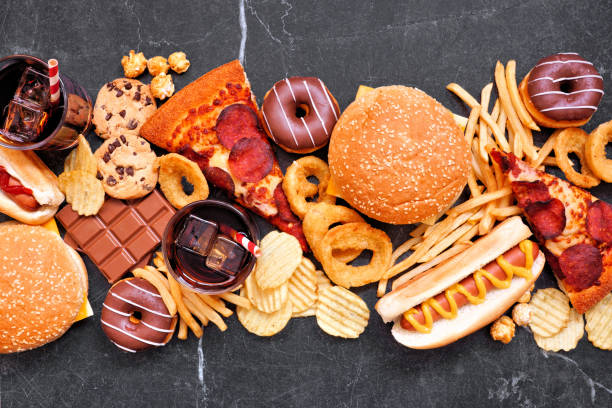
Introduction
In an era where health and fitness are becoming increasingly prioritized, understanding the role of fattening foods in our diet is crucial. Fattening foods, characterized by their high calorie content, poor nutritional value, and propensity to contribute to weight gain, have become ubiquitous in modern diets. This article explores what makes food fattening, the types of fattening foods, their effects on health, and strategies for mitigating their impact on our waistlines.
What Makes Food Fattening?
The term “fattening” typically refers to foods that are calorie-dense and nutrient-poor. These foods often contain high levels of sugar, unhealthy fats, and refined carbohydrates. Let’s break down the key components:
High Caloric Density
Foods with high caloric density pack a lot of calories into small servings. Examples include fried foods, sugary snacks, and processed foods. These foods can lead to excessive calorie intake, contributing to weight gain.
Low Nutrient Density
Fattening foods often lack essential nutrients such as vitamins, minerals, and fiber. Consuming these foods can lead to nutritional deficiencies while still contributing to weight gain due to their high caloric content.
High Sugar Content
Foods high in added sugars, such as candies, sodas, and baked goods, are major contributors to weight gain. Excessive sugar intake can lead to insulin resistance, increased fat storage, and heightened appetite.
Unhealthy Fats
Trans fats and saturated fats, commonly found in fast food, processed snacks, and baked goods, can promote weight gain and negatively impact heart health. These fats are more likely to be stored in the body as visceral fat, which is particularly harmful.
Common Fattening Foods
Fast Food
Fast food is a major contributor to obesity. Items like burgers, fries, and fried chicken are calorie-dense and often loaded with unhealthy fats, sugars, and sodium. These foods are designed to be hyper-palatable, making them difficult to resist and easy to overconsume.
Sugary Beverages
Sugary beverages, including sodas, energy drinks, and sweetened coffees, are among the leading sources of added sugars in the diet. They provide empty calories and can significantly increase daily caloric intake without providing satiety.
Baked Goods
Pastries, cakes, cookies, and doughnuts are typically high in both sugars and unhealthy fats. They are also often made with refined flours that have been stripped of their nutritional value, making them both calorie-dense and nutrient-poor.
Processed Snacks
Chips, crackers, and other processed snacks are usually high in refined carbohydrates and unhealthy fats. They are designed for convenience and extended shelf life, but their nutritional profiles are often lacking.
Candy and Sweets
Candies and sweets are primarily composed of sugars and unhealthy fats. They provide a quick burst of energy followed by a rapid drop, which can lead to increased hunger and overeating.
The Health Effects of Fattening Foods
Weight Gain and Obesity
The most direct impact of consuming fattening foods is weight gain, which can lead to obesity. Obesity is associated with a range of health issues, including type 2 diabetes, heart disease, stroke, and certain cancers.
Metabolic Syndrome
A diet high in fattening foods can lead to metabolic syndrome, a cluster of conditions that increase the risk of heart disease, stroke, and diabetes. These conditions include high blood pressure, high blood sugar, excess body fat around the waist, and abnormal cholesterol levels.
Insulin Resistance and Type 2 Diabetes
Excessive intake of sugary and high-fat foods can lead to insulin resistance, where the body’s cells do not respond properly to insulin. This can result in elevated blood sugar levels and eventually type 2 diabetes.
Cardiovascular Disease
Unhealthy fats found in many fattening foods can raise levels of LDL (bad) cholesterol and lower levels of HDL (good) cholesterol, increasing the risk of heart disease. High sodium levels in processed foods can also contribute to hypertension, further elevating cardiovascular risk.
Digestive Issues
A diet low in fiber, common in those who consume large amounts of fattening foods, can lead to digestive problems such as constipation and irritable bowel syndrome (IBS). Additionally, these foods can disrupt the gut microbiome, which plays a crucial role in overall health.
Psychological Impact
Addiction and Cravings
Many fattening foods are designed to be highly palatable, triggering the brain’s reward system and creating a cycle of cravings and overconsumption. This can lead to food addiction, making it difficult to control eating behaviors.
Emotional Eating
Fattening foods are often used as comfort foods, providing temporary relief from stress and negative emotions. This can lead to emotional eating, where individuals use food as a coping mechanism, further contributing to weight gain and poor health.
Strategies for Reducing Fattening Foods in the Diet
Awareness and Education
Understanding the nutritional content of foods is the first step in making healthier choices. Reading food labels and being aware of ingredients can help individuals identify and avoid fattening foods.
Meal Planning and Preparation
Preparing meals at home allows for better control over ingredients and portion sizes. Planning meals and snacks in advance can help prevent impulsive choices that lead to the consumption of fattening foods.
Healthy Substitutions
Making simple substitutions can significantly reduce the intake of fattening foods. For example, swapping soda for water, choosing whole grains over refined grains, and incorporating more fruits and vegetables into the diet can make a big difference.
Mindful Eating
Practicing mindful eating involves paying attention to hunger and fullness cues, eating slowly, and savoring each bite. This can help reduce overeating and improve the overall eating experience.
Physical Activity
Regular physical activity is essential for maintaining a healthy weight and counteracting the effects of consuming fattening foods. Exercise helps to burn excess calories, build muscle, and improve metabolic health.
The Role of Policy and Environment
Food Labeling and Marketing
Improved food labeling can help consumers make informed choices by clearly displaying nutritional information and warning about high sugar and fat content. Regulating marketing, especially to children, can also reduce the consumption of fattening foods.
Access to Healthy Foods
Increasing access to healthy, affordable foods is crucial in combating the prevalence of fattening foods. Community programs, subsidies for fresh produce, and support for local farmers’ markets can help make healthier options more available.
Education Programs
Implementing nutrition education programs in schools and communities can raise awareness about the dangers of fattening foods and promote healthier eating habits from a young age.

Conclusion
The prevalence of fattening foods in modern diets is a significant contributor to the global obesity epidemic and related health issues. Understanding what makes foods fattening, their health impacts, and strategies to reduce their consumption is crucial for improving public health. By making informed choices, planning meals, and advocating for healthier food environments, individuals and communities can take meaningful steps toward a healthier future. The journey to better health involves not only personal responsibility but also collective efforts to create environments that support healthy living.














